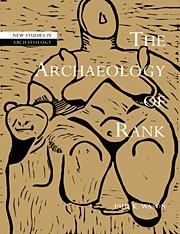Book contents
- Frontmatter
- Contents
- List of figures and tables
- Acknowledgments
- 1 The present study of past society
- 2 Social theory and social life: models of society in the archaeological study of status
- 3 Inequality and social life: a working model
- 4 Mortuary data as evidence of ranking, Part 1
- 5 Mortuary data as evidence of ranking, Part 2
- 6 The form and distribution of artifacts
- 7 Status, settlements, and structures
- 8 Çatal Hüyük: a ranked Neolithic town in Anatolia?
- Notes
- References
- Index
- NEW STUDIES IN ARCHAEOLOGY
2 - Social theory and social life: models of society in the archaeological study of status
Published online by Cambridge University Press: 22 August 2009
- Frontmatter
- Contents
- List of figures and tables
- Acknowledgments
- 1 The present study of past society
- 2 Social theory and social life: models of society in the archaeological study of status
- 3 Inequality and social life: a working model
- 4 Mortuary data as evidence of ranking, Part 1
- 5 Mortuary data as evidence of ranking, Part 2
- 6 The form and distribution of artifacts
- 7 Status, settlements, and structures
- 8 Çatal Hüyük: a ranked Neolithic town in Anatolia?
- Notes
- References
- Index
- NEW STUDIES IN ARCHAEOLOGY
Summary
The intent of social archaeology is to understand a former way of life in the same terms we use to study modern society. I do not believe this is at odds with efforts to understand the past “on its own terms,” but certainly it is different. Whether or not any current approach really tells us what the participants would have said about themselves, social archaeology does not even try. Yet this does not exclude us from saying something real and significant about life in the past, for in describing former societies in terms roughly comparable to a social anthropologist's understanding of living societies, it provides a basis for answering questions about the nature and history of social life. Its method is the application of social theory to the findings of excavation, which is a dangerous business, for if we are not careful we can easily “read into” the data what is not there. Hopefully, we know better than to expect “pure objectivity,” but neither have I seen any compelling argument for the contrary assertion, that the use (imposition) of Western social theory (our models of society) inevitably negates the past, subsuming it as a self-serving extension of the present.
A model is a representation to help us visualize something we either cannot observe directly, or wish to see from a different angle. Many central concepts of anthropology – society, culture, status – are models in this sense.
- Type
- Chapter
- Information
- The Archaeology of Rank , pp. 15 - 35Publisher: Cambridge University PressPrint publication year: 1994

